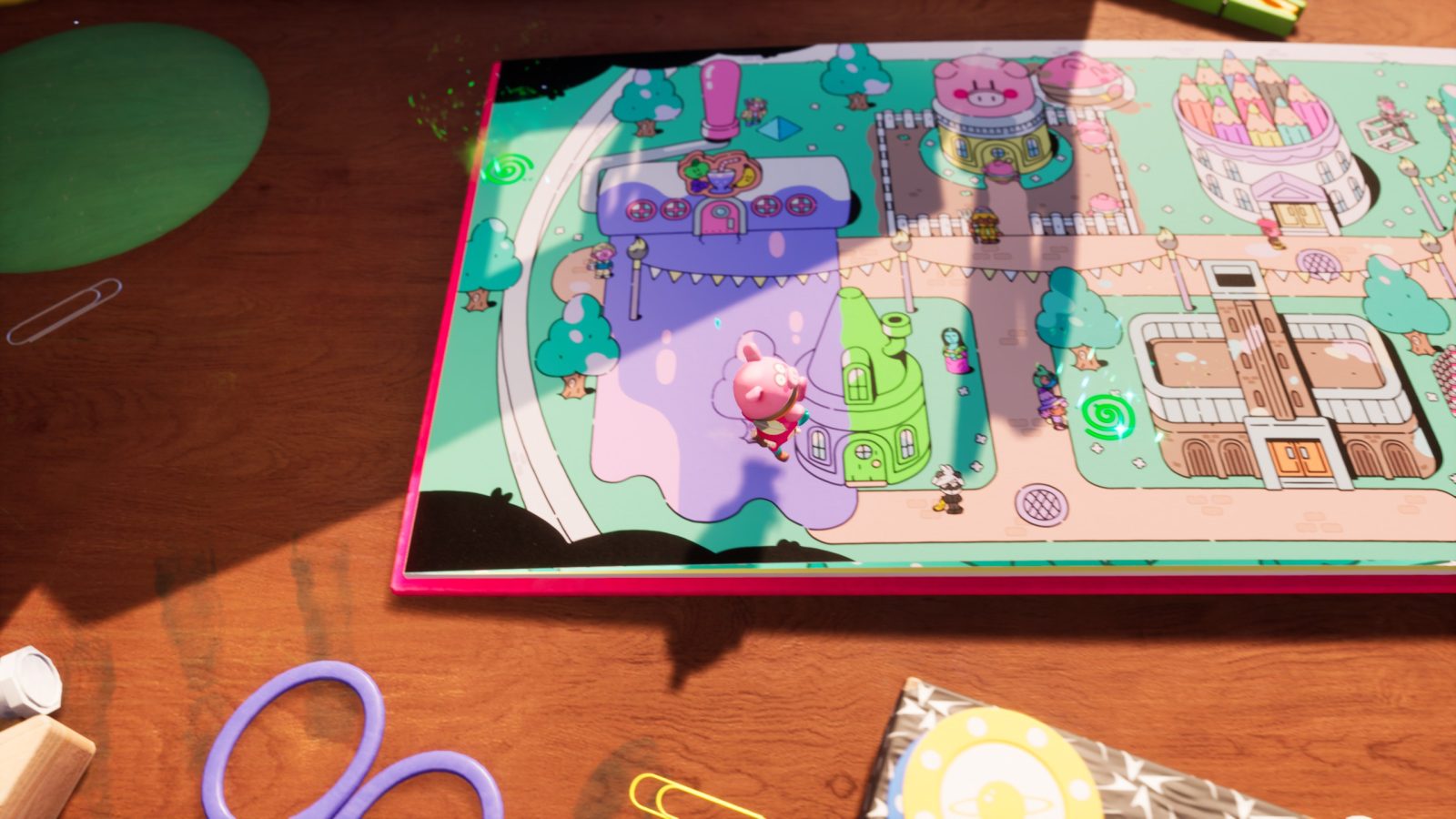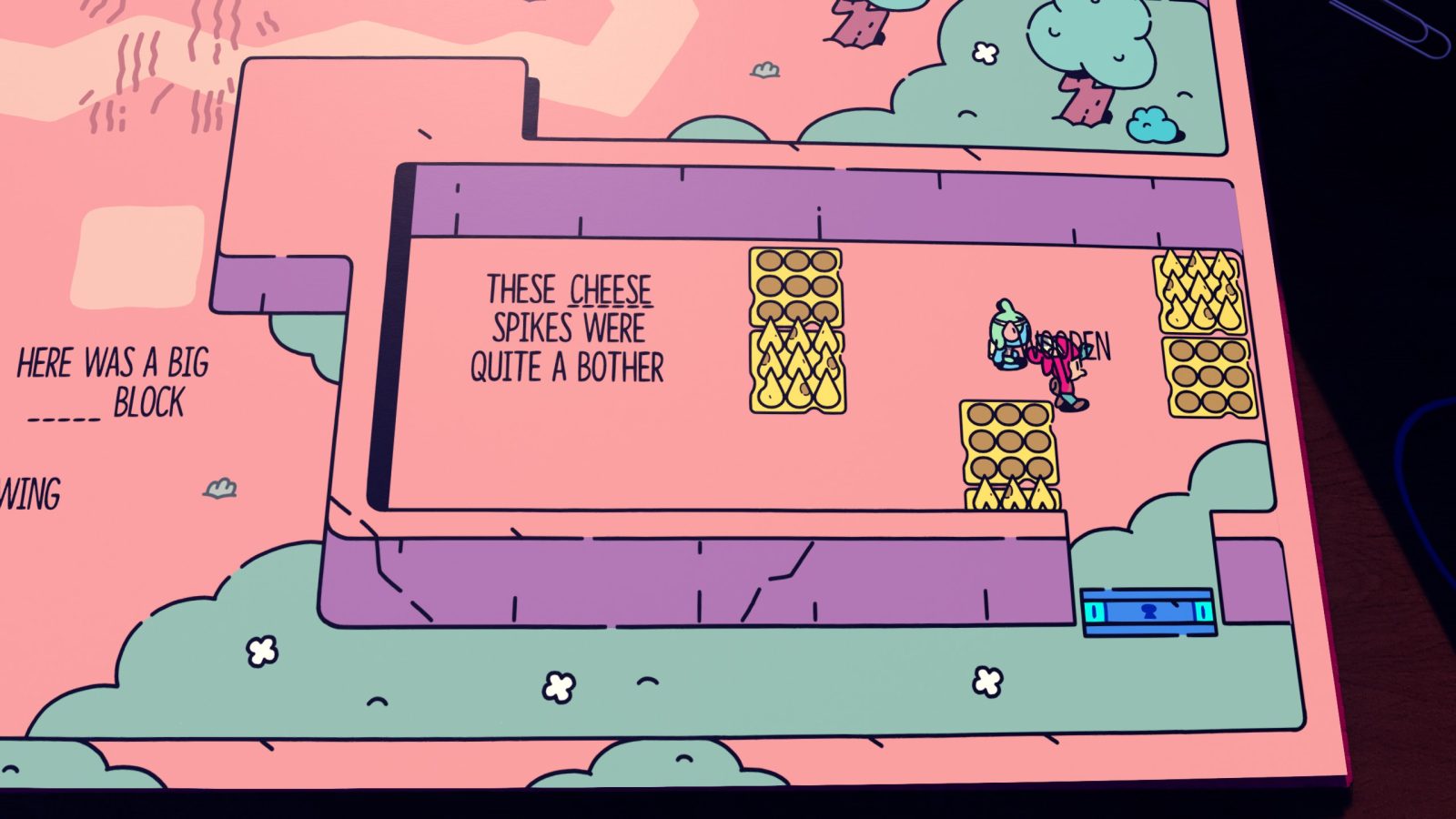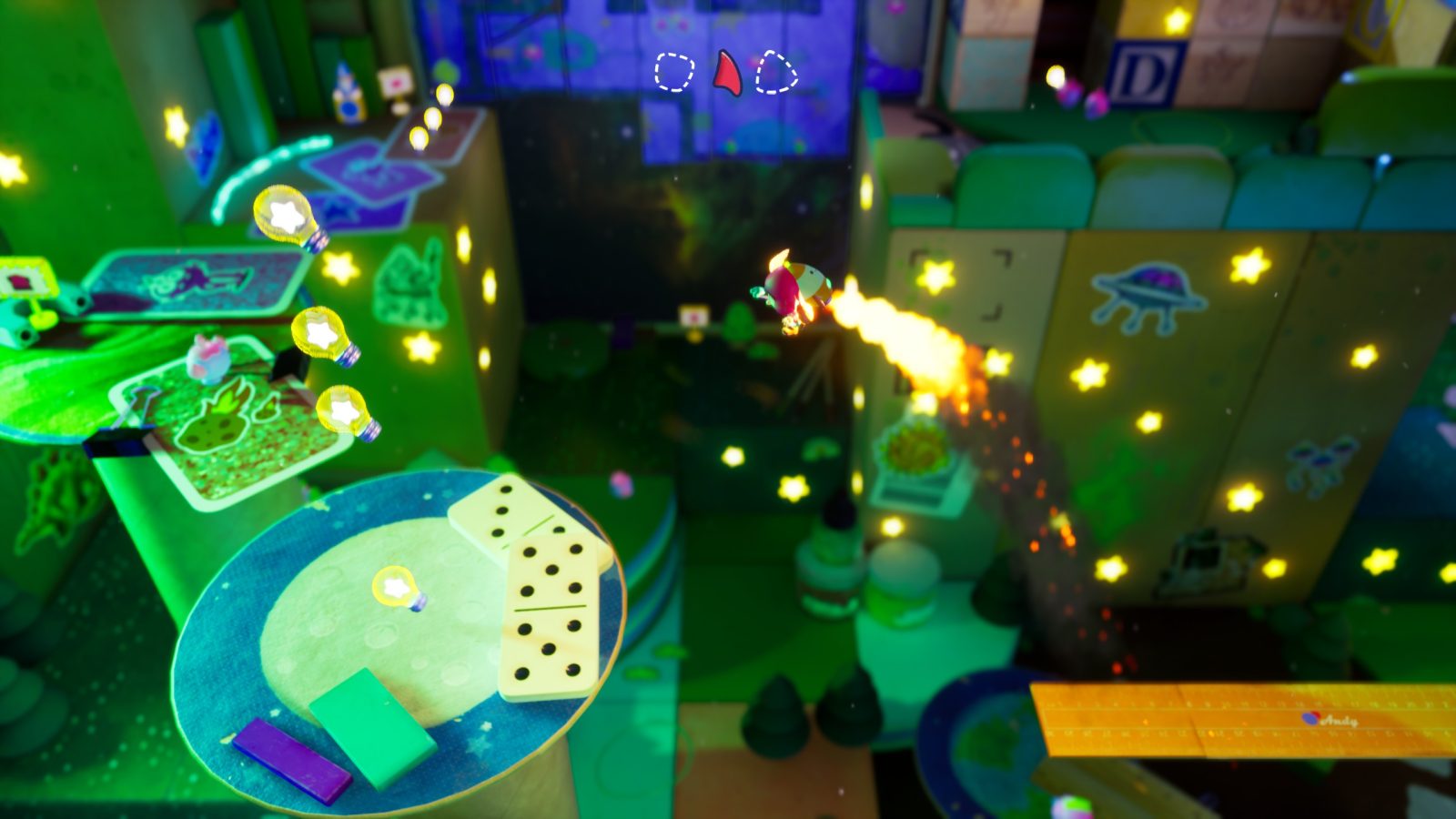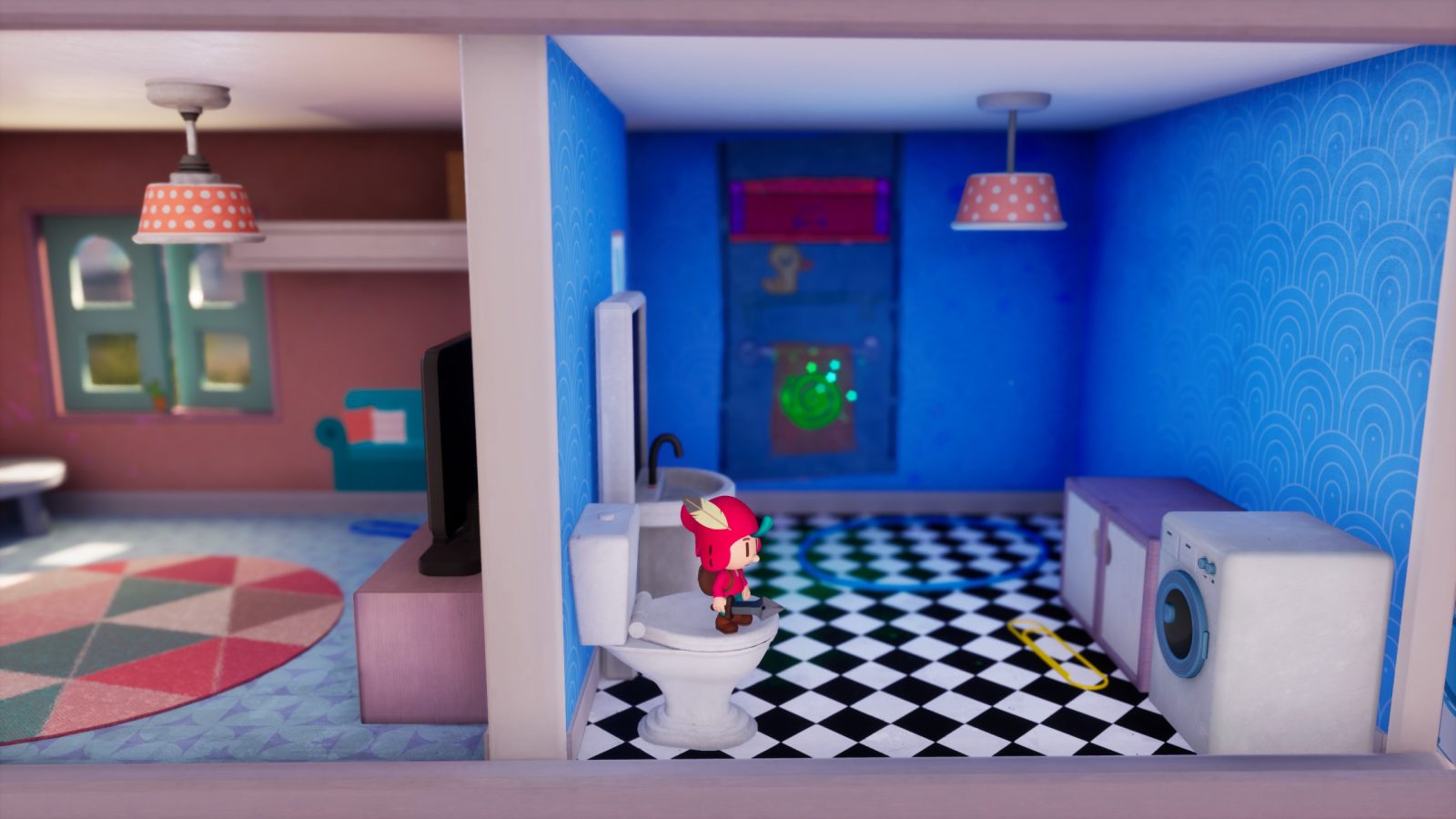
In the land of Mojo, the Plucky Squire’s stories are all the rage. Jot writes of his adventures stopping the evil mage Humgrump. One adventure that begins like any other quickly evolves into one that sends Jot out of the storybook he lives in and into the real world. Jot’s storybook, The Plucky Squire, is owned by a boy named Sam. Sam will one day grow up and, inspired by this book from his childhood, write his own series of children’s storybooks which will then go on to inspire other children. That is, if Jot can stop Humgrump from ruining the story with his Meta Magic. So, alongside his friends Violet and Thrash, Jot embarks on a quest to save both the fictional and real worlds.
It’s hard not to be enamored with The Plucky Squire from the moment you begin the game. It’s absolutely adorable! The art style captures the storybook aesthetic perfectly, with thick outlines, bright colors, and a realistic papery texture on top. It’s got the right attitude too, with tons of puns and other jokes. The Plucky Squire is a very joyful experience, constantly trying new things to surprise and delight you. However it does falter in a few places, making the game as a whole feel a bit uneven.
Gameplay inside the book usually takes place from a top down perspective. Jot can run around, swing, throw, or spin his sword, jump, and interact with objects to defeat enemies and solve puzzles. Puzzles often involve (pun intended) wordplay, with Jot being able to pick up certain words in the book’s narration and swap them around for different effects. For example, you can turn a metal box into cheese or make a closed gate open. It’s incredibly creative, and if a word fits properly in a sentence it’ll almost always have an effect, even if it doesn’t help you solve the puzzle at hand.
These puzzles get a new dimension when Jot can jump out of the book. There might be a word you need on another page or you can tilt the whole book to move certain objects around. You’ll gain more tools to manipulate the book as you progress through the game, and it’ll keep introducing new and novel ways to interact until the very end.

To get those new tools, you need to explore Sam’s desk, which is completely redecorated each time. The desk might be dinosaur themed or decorated with stars to recreate a galaxy, both introducing their own gimmicks I won’t spoil here. These sections play basically the same as those within the book, which leads to the biggest praise I have for The Plucky Squire: despite combining 2D and 3D it all feels totally seamless – aside from the seam in the book itself, I mean. Unless you’re actively looking for it, you won’t see when Sam’s desk changes in the background or the subtle lighting changes on the book’s surface. On PC there were times the game stuttered a bit when loading something, but other than that going from 2D to 3D and back again feels totally natural. It’s clear a lot of care was taken to make this happen, and I applaud the team at All Possible Futures for pulling it off.
It’s not flawless though, as The Plucky Squire is very glitchy. There were several times where my companions wouldn’t follow Jot, completely skipping some crucial dialogue on the next page. It’s nice that this doesn’t break the game completely as you can still progress without them, but I wanted to see the story so this was a frequent frustration. To fix it I had to reload a previous autosave, an incredibly handy feature, but this often required me to redo a puzzle I had just solved for the chance at fixing the glitch.

The other major glitch I encountered was, ironically, with the collectable Glitchbirds. These little friends are fiendishly hidden throughout the game and collecting them all will… do something. I found about 7 or 8 in my playthrough, but the counter kept resetting sometimes after exiting the game. By the time I reached the credits, the game thought I had only found 4 total. In terms of minor glitches, early on the shop NPC was completely invisible, then she later became a mess of artwork glitching around, before finally settling down after an update. The developers are still hard at work squashing bugs, but there’s still a ways to go before it’s entirely stable.
In the middle of the review period, The Plucky Squire became Steam Deck Verified, and I’m happy to say it plays just fine there. You’ll encounter the same glitches, but thankfully no new ones pop up because of the hardware or Linux compatibility layer. Oddly the title screen uses the full 16:10 aspect ratio while the rest of the game is in 16:9, but that’s not a big deal. You’ll have to sacrifice a bit of fidelity if you want consistent 60 fps on the Deck, but other than that it achieves parity with a windows PC.

While we’ve talked about the normal gameplay modes, The Plucky Squire is filled to the brim with various minigames that essentially serve as the game’s boss fights. There’s one in the style of punch out, a shooting gallery, a puzzle game, and even a Rhythm Heaven inspired rhythm game. These are nice ways to break up the pace, though I do find that they all go on just a little too long, particularly the punch out one. They’re all enjoyable in their own way, but after a while I felt like I had gotten my fill and demonstrated my skill, with the minigame only being halfway or two-thirds over. They’re not particularly difficult, a statement that applies to the game as a whole, so making them short and sweet rather than just sweet would have been appreciated.
Speaking of difficulty, adults and teens should have no trouble getting through The Plucky Squire. I did encounter a game over or two, but that was mostly due to carelessness or panicking during the puzzle minigame. Dying simply restarts the current section regardless, so it’s not very punishing. Much like the book within the game, the main audience seems to be young kids, though anyone can enjoy it of course. For really young players or anyone who wants to just enjoy the story, there’s also a Story Mode difficulty with weaker enemies and jump assist enabled by default. There are a few accessibility options you can turn on on any difficulty as well, such as showing hidden portals, disabling falling platforms, invincibility, and one hit kills. You can swap the functionality of the left and right sticks too on top of rebinding controls on a gamepad or keyboard and mouse. There are enough options here that just about anyone can enjoy the game to their liking regardless of their age or ability.

Finally, let’s touch on the story and music. While none of the tunes really stood out to me, not even in the rhythm minigame, I think they all fit the game’s lighthearted tone and various genres nicely. It’s good at accompanying and accentuating the gameplay rather than standing on its own. Much like most of the technical aspects, it fades into the background. Conversely, while the story is a driving focus, I found portions of it sloppily told. Don’t get me wrong, it’s still enjoyable with a good message, and while you’re not supposed to think too hard about it there were a few moments that should have had impact but just passed nonchalantly. This is best seen in Jot’s friends, Violet and Thrash. Both of them have character arcs, but Violet is absent for a majority of the story and Thrash’s arc… is less of an arc and more of a straight line with no tension or doubt. At no point does he question if he can do the things he needs to, he’s more just like “OK.” and does them. It’s funny in a way and fits his character, but it completely loses whatever message was supposed to be there. Violet, meanwhile, just didn’t get the time she needed to develop. Her arc does have that doubt in it, but it’s overcome almost in an instant each time. There’s also several points in the ending that could have used more fleshing out, particularly with Humgrump and the mysterious hooded figure. I don’t want the story to be complex or anything, but I think it could have been much more enjoyable if it focused on the right things rather than just passing like a breeze as it does now.
The Plucky Squire
Excellent
The Plucky Squire is an adorable adventure for everyone to enjoy. It has some issues, like glitches and a less than stellar story, but plucky really is the right word to describe the game. It's technically ambitious and impressively varied, making it easy to forgive its shortcomings.
Pros
- Adorable and pun-filled
- Seamless jumps from 2D to 3D
- Great puzzles
Cons
- Minigames go on a bit too long
- Glitchy
- Story can feel sloppy
